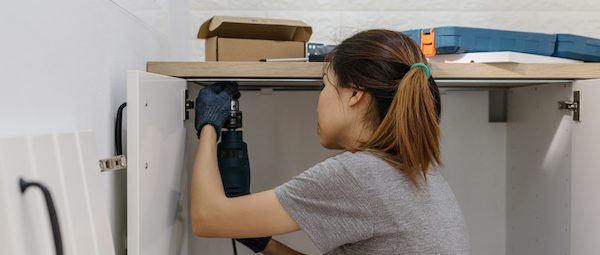Build Your Down Payment With a Sweat Equity Mortgage

Some or all of the mortgage lenders featured on our site are advertising partners of NerdWallet, but this does not influence our evaluations, lender star ratings or the order in which lenders are listed on the page. Our opinions are our own. Here is a list of our partners.
Saving a down payment is challenging for many first-time home buyers, and even if they manage it, more obstacles lie ahead. After choosing a lender and getting approved, buyers still have to find a good house that fits their budget. Looking at fixer-uppers can expand their options, but not everyone can afford major improvements after such a big purchase.
Buyers could find a solution in Home Possible, a low-down-payment conventional mortgage from Freddie Mac. These loans offer an attractive option for borrowers willing to apply a little elbow grease: a sweat equity provision that can eliminate the need for a cash down payment.
Sweat equity allows buyers to “earn” their entire down payment by improving a home before purchase, says Danny Gardner, senior vice president of affordable lending at Freddie Mac. Buyers do the work themselves, and the change in appraised value after the renovations becomes a credit they can apply to the purchase.
Some conditions apply: Using the sweat equity feature requires home improvement know-how and money to purchase materials. The sellers also must be willing to let someone work on their house before buying it.
But in the right situation, this feature gives first-time home buyers more bang for their buck, particularly in markets where move-in ready starter homes are hard to come by.
Young homeowners love to DIY
America’s desire to bootstrap home improvements could be attributed in part to something known as the “HGTV effect,” which refers to a recent surge of popular home improvement reality shows and YouTube channels featuring do-it-yourself experts.
Thirty-eight percent of all home renovation projects are DIY, according to NerdWallet’s 2018 Home Improvement Report.
Younger homeowners are especially eager to roll up their sleeves — those under age 35 complete more than half of all their own home repair and improvement projects instead of hiring a professional. As a result, they spend several hundred dollars less on a typical project, the report found.
With sweat equity, DIY-obsessed home buyers may be able to channel that energy into a more affordable home.
Who can use the sweat equity feature?
Buyers interested in the sweat equity feature should talk with a lender that offers Home Possible loans. The option is open to any borrower who meets general financial guidelines.
“Home Possible is a great loan program,” says Keith Kampe, vice president of sales at Flagstar Bank. “The only challenge is getting people into it, because there are income limits.”
The program sets household income limits by census tract, an area that’s usually similar to a neighborhood in size. Freddie Mac has an eligibility tool that lets users see the limits by property address.
How the sweat equity feature works
No matter how you slice it, buying a house requires some money upfront. For sweat equity borrowers, each dollar spent improving the property before purchase pulls double duty as a credit toward their down payment.
But before they can break out the power tools, sweat equity borrowers have to find the right house and a seller who’s comfortable with the unique arrangement.
“There has to be a lot of trust there between buyer and seller,” says Joe Zucht, a loan originator at NBKC Bank. Those looking to buy from a friend, family member or their current landlord may already have that trusting relationship, he says.
If both parties are on board with a sweat equity arrangement, the buyer’s real estate agent will draft an offer that describes all planned improvements and explains what will happen if the deal falls through. Once the agreement is signed, the work must be completed by the buyer before the loan closes — in other words, before he or she owns the house.
Sweat equity borrowers should also be ready for an appraiser to look over their shoulder throughout the process. The appraiser will estimate the value of the remodel and verify that the materials and workmanship match what was promised in the contract.
Anchor DIY aspirations in reality
It’s important for sweat equity borrowers to choose their presale improvements strategically, weighing the money and effort required against the down payment credit they’ll earn. Buyers should also be realistic about their DIY skills and avoid biting off more than they can chew.
While some changes are merely cosmetic, others are capital improvements that can significantly increase the property's value, extend its useful life or adapt it for new uses. These are typically bigger projects that could include installing a new roof, renovating the kitchen or adding a garage.
Even though it’s a more intense commitment, Gardner says buyers who hope to capture the full benefit of their sweat equity should “focus on capital improvements because once you become the owner of that home, you can always make the cosmetic improvements.”

